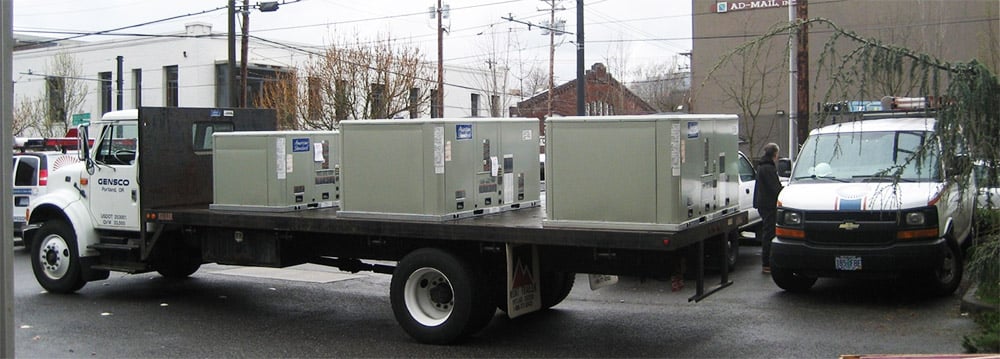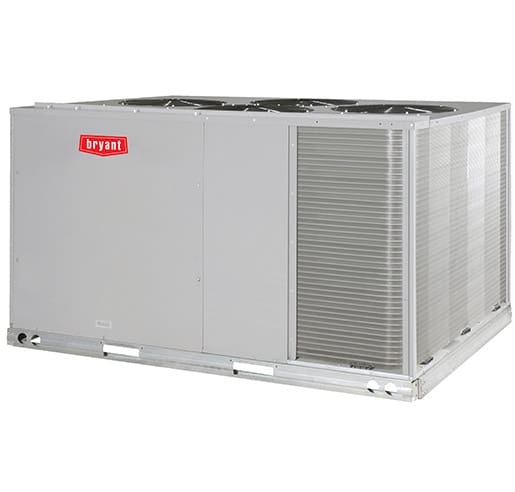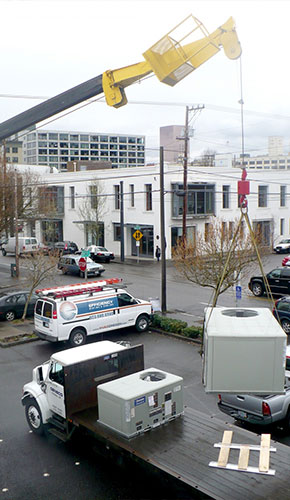Efficiency Heating & Cooling
Commercial HVAC Experts Serving the Portland Area
Get dependable commercial HVAC services with Efficiency Heating & Cooling. We offer industrial HVAC solutions that focus on energy efficiency, maintenance, and installation in the Greater Portland Area.
Read Real Reviews About Our
Greater Portland HVAC Contractors
Local Commercial Heating and Cooling Company
We tell our residential customers all the time that the design and installation of their comfort system plays a huge role in performance, reliability and efficiency. Multiply that truth by the size and requirements of a commercial system, and it places commercial HVAC design build at a wildly important level. Our technicians are trained, experienced and competent, and we’re a Portland commercial HVAC company you can rely on for some of the finest service in the industry. We don’t merely take care of your present needs, but help you accurately forecast for future demands.
Commercial HVAC Repair & Maintenance in Portland Metro
Efficiency Heating & Cooling is a leader in commercial repair, retrofit, and maintenance services for all brands and types of HVAC equipment. Our skilled employees know how to accurately troubleshoot equipment using knowledge compiled from years of experience. We look beyond immediate issues, and also identify weaknesses that can cause future reliability issues. Basically, if you want a Portland commercial HVAC company that you can rely on to keep your business or facility comfortable, you need to give us a call.
Commercial HVAC Maintenance Portland
Efficiency Heating & Cooling will help stabilize your monthly operating costs with effective maintenance services. Maintenance on your commercial HVAC system can extend equipment life as well, resulting in an overall win for your bank account!
Our skilled technicians are also very good at noticing potential problems that could affect you down the road. When you rely on our company, your comfort is protected now and on into the future. Enjoy the complete assurance that each of our customers enjoys. We do things the right way, the first time, every time. You’ll notice the difference right away!
Commercial Ducting & Ventilation for HVAC Systems
What’s a quality HVAC system without proper ducting and ventilation? It’s crazy how many buildings lose massive amounts of energy due to poor ducting and other energy leaks.
If you need custom sheet metal work, ducting repair or just an analysis to ensure you’re not wasting money due to problems, give us a call.
Our attention to detail, industry experience and exceptional customer service will blow you away. In fact, we know that once you call us the first time, you’ll never call anyone else.
We really do treat our customers that well. Thank you for considering Efficiency Heating & Cooling, a leader in Portland commercial HVAC solutions.

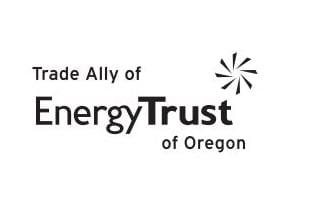
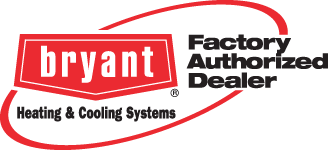







More Information
Searching for a Commercial HVAC Company Near Me?
The commercial HVAC requirements of industrial and commercial properties are significantly more complicated than residential properties.
The greatest distinction between residential and commercial HVAC systems is their overall size and power capacity. Residential systems are usually smaller sized with much lower power requirements. Industrial properties vary from little stores like coffee shops to big workplace structures and storage facilities.
Because of these varying usage cases, commercial HVAC system installation must meet a spectrum of heating and cooling demands.
What type of gas is typically used in commercial HVAC systems?
Natural gas or propane are the most common gases used in commercial HVAC systems.
How does fluid flow work in a commercial HVAC system?
Fluids such as refrigerants and water circulate through pipes, valves, and pumps to transfer heat from one place to another for cooling or heating.
What is a duct system and how does it help regulate air flow in a commercial HVAC system?
A duct system is made up of connected tubes used to distribute air throughout a building. The size, shape, and location of these ducts allow air to be directed to specific areas for heating or cooling according to the needs of the space.
Are there any safety measures that should be taken when working with commercial HVAC systems?
Yes, some safety measures include wearing protective gear such as gloves and goggles when handling chemicals such as refrigerants; following instructions when installing equipment; avoiding contact with hot surfaces; and having an emergency shut-off switch for quickly turning off power if needed.
What type of maintenance is required for a commercial HVAC system?
Regular maintenance should include checking electrical components, inspecting fans and motors, cleaning condenser coils, changing filters regularly, testing pressure levels, and checking the thermostat settings.
Types of Commercial Heating and Cooling Systems used by Commercial HVAC Companies
The standard options that you might see in a large-scale commercial HVAC are:
Commercial HVAC Roof Installations: Located on the roof covering, these commercial heating and cooling systems make use of air ducts to push the air right into the location. In contrast, residential systems are commonly found on the side of a house.
Commercial Heating Systems: The two kinds of heating units are radiant air heating systems for straight warmth, or warm air heaters with heat recovery.
Commercial Heat Pumps: A commercial heat pump works by heat being removed from water or the air for heating a commercial space. With a water-based heat pump, water goes through a pipeline to supply the commercial heat pump.
Commercial Chilling Systems / Commercial Chillers: Cool water is produced and also dispersed to air cooling coils by means of a pipeline.
Commercial Single Split HVAC System
Commercial single split systems are one of the most inexpensive types of commercial indoor unit for HVAC building systems. Depending upon one’s needs and taking the time to determine HVAC system selection impact, these could also be appropriate for smaller structures.
Since commercial single split systems can warm a space as well, it makes them suitable for stores, web server spaces, cafés, as well as small to medium-sized commercial areas.
For light commercial applications, you can additionally utilize a commercial single split indoor unit in larger locations. The only consideration is that there needs to be an adequate outside area to mount an equivalent exterior system for every interior single split system.
The benefits of commercial single split systems:
- It is less costly than mounting a main system.
- Each single split system is self-supporting, so if one device breaks down, it will not impact the others.
- As your company expands, you can include cooling capability in a one-to-one proportion.
- It is a less costly compared to other building systems, and it is extremely flexible and energy efficient.
What are Commercial Multi-Split System Air Conditioning Systems?
Commercial multi-split systems function similarly to single-split systems used in residential HVAC systems. However, you can link extra interior devices to the one exterior system.
This system is usually utilized in dining establishments, stores, and other designated commercial building locations. The fewer exterior devices required means more space and visual appeal.
Commercial Variable Refrigerant Volume (VRV) & Variable Refrigerant Flow (VRF)
Variable Refrigerant Volume (VRV) and Variable Refrigerant Flow (VRF) describe the exact same commercial HVAC system technology. This is an excellent commercial HVAC option for resorts, large workspaces, and retail areas.
Efficient commercial HVAC systems like VRF HVAC systems as well as VRV systems utilize heat pumps for heating. Commercial heat pump systems offer heating or cooling to a structure at any time.
Commercial heat recovery systems have the ability to give synchronized space heating / cooling to a variety of locations at the exact same time. A new commercial HVAC system using heat recovery makes it a great option for a structure with numerous spaces.
Efficient HVAC systems for commercial use recuperate wasted warmth from around the structure and utilize it to warm water and other spaces.
Commercial A/C installation with warehouse integration
Integrating individual HVAC systems with various other air conditioning alternatives is an excellent suggestion in a storehouse. Large ceiling fans set on high volume/low rate can assist to reduce the temperature level in your storage facility significantly. To scale commercial HVAC system options, the mix of a commercial portable box fan with an improved misting system is a great way to reduce costs.
How Does a Commercial Heating and Cooling System Work?
A common question is how does a commercial HVAC system work? In short, it helps to regulate the temperature level within a commercial or industrial building. While household centralized HVAC system are small and designed to cool a single residence, commercial HVACs control the climate of large buildings.
What are Commercial HVAC Solutions?
In the HVAC industry, HVAC stands for home heating, air flow and also air conditioning. An HVAC system offers cooling and heating within an area, and it is typically a combination of air conditioning, furnaces or heat pumps. Commercial HVAC units are utilized for bigger areas such as offices, hotels, restaurants, movie theaters and more. These commercial systems are a lot more durable and designed for a commercial space.
Such commercial air systems typically include:
Thermostat: The thermostat is what regulates the HVAC system. It indicates the system to generate warm or awesome air depending upon the temperature level collection.
Heating system: The heating system is the biggest part of your HVAC system, offering the warmth.
Warm exchanger: The warmth exchanger is discovered within the heating system as well as is utilized to heat up the air drew in by the heater.
Cooling agent lines: These lines transform refrigerant compounds right into fluid type for air conditioners.
Ductwork as well as vents: The ductwork as well as vents transfer warmed or cooled air from air conditioners into your organization or industrial structure.
Why have a commercial HVAC systems installed?
The HVAC system in most light commercial buildings assists in 3 various procedures consisting of home heating, air flow as well as A/C and even a heat recovery system. Each procedure needs its very own specific device that when with each other, produces your HVAC system, managed by your main thermostat connected to a corresponding outdoor unit.
Heating
For HVAC systems with heaters, the thermostat will begin the home heating procedure by indicating the heater. A gas shutoff within the heater will certainly available to fire up the burner. Next off, the warm created from the heater is after that made use of to heat up the warm exchanger. The warm is after that changed right into air as it streams via the exchanger.
When the warm becomes air, it is dispersed making use of an inner electric motor as well as follower connected to the heating system. The warmed air is sent out with the ductwork situated throughout the business structure and it can be recycled using a heat recovery system.
Air flow
Commercial air conditioning is highly dependent upon A/C systems with appropriate air flow for optimal indoor air quality. Air flow permits the proper quantity of fresh air to enter your industrial room, no matter home heating and also cooling down treatments. Without this fresh air, you could smell mold and mildew, and also other airborne impurities that can accumulate in commercial HVAC equipment.
Air conditioning
The A/C unit within commercial HVAC equipment will make use of air conditioning refrigeration to cool down the air. Cooling agents, or the compounds utilized to take in the warm, begin in a gas type and then a compressor is used to press the gas, raising the temperature in energy efficiency commercial HVAC equipment.
As soon as the gas is correctly pressurized, it is moved right into a condensation coil, which launches the warmth as well as transforms the gas right into a cooler fluid. A blower takes in the cozy air and also launches it over an evaporator. The fluid ends up being a cooler gas once more, takes in the warm from the air and also efficiently cools it in a modern air conditioning system.
As the biggest part of your HVAC system as well as among one of the most crucial, your heating system must remain in excellent condition at all times. Appropriate industrial HVAC upkeep ought to be set up to guarantee your internal heating system and corresponding outdoor unit remain in good working order. Concerns such as broken warm exchangers, underperforming heat pumps, and also excess carbon monoxide gas can have severe impacts on the HVAC system not to mention indoor air quality.
To maximize efficiency, all 3 systems in an HVAC system rely upon each other for correct temperature level policy and also air flow for optimal indoor air quality. Your heater as well as various other parts of your HVAC system must be serviced a minimum of as soon as each year to secure your industrial building.
Seeking Commercial HVAC System Installation?
HVAC maintenance is crucial to your industrial or commercial property, HVAC system installment is likewise crucial and also ought to be left to the specialists. To find out more concerning correct business HVAC system setup, call us or call us.
Related Information
How does a commercial HVAC system work?
How long do commercial HVAC systems last?
How much does a new commercial HVAC system cost?
How much is a commercial HVAC system?
What is a commercial HVAC technician?
What is light commercial HVAC?
What is the life expectancy of a commercial HVAC unit?
What percentage of commercial building cost is HVAC?
What’s better residential or commercial HVAC?
Understanding the Fundamentals
At Efficiency Heating & Cooling, we focus on providing high-quality commercial HVAC systems tailored for commercial properties. Our systems use the latest technology to ensure effective heating and cooling, helping create a comfortable and dependable workplace.
What is a commercial HVAC system?
A commercial HVAC system is a setup for managing heating, ventilation, and air conditioning in larger buildings. It includes:
- Heating: Keeps spaces warm during cold months.
- Cooling: Helps maintain a pleasant temperature in hot weather.
- Ventilation: Brings in fresh air and helps circulate it indoors.
These HVAC systems play a vital role in ensuring a comfortable indoor environment in various commercial properties, like offices, retail spaces, and warehouses.
How does a commercial HVAC system work?
Knowing how a commercial HVAC system works is key for good maintenance and quick fixes. Here’s a simple breakdown:
- Air Handler: This part pulls in air, cleans it, and sends it throughout the building.
- Ventilation: Fresh air from outside mixes with indoor air to keep the air quality good.
- Temperature Control: Thermostats set the desired temperature to keep things comfy.
- Energy Management: Newer systems use sensors and controls to save energy.
When it comes to HVAC design services and commercial air conditioning, professionals can help with proper installation and efficiency. If issues arise, HVAC troubleshooting can help find solutions quickly.
Benefits of installing a commercial HVAC system
There are many perks to putting in a commercial HVAC system:
- Efficiency: Saves on energy bills by using modern energy-efficient HVAC options.
- Indoor Air Quality: Better air circulation and cleaning lead to healthier spaces.
- Savings: Long-term savings from lower energy costs and less maintenance.
- Comfort: Maintains a steady and pleasant atmosphere for workers and customers alike.
Choosing our commercial HVAC solutions means investing in quality and comfort for your business.
Energy efficiency considerations for commercial HVAC systems
When thinking about a commercial HVAC system, consider energy efficiency as a top priority. Here are some important factors:
- Energy Management Systems: These help track and control how much energy you use.
- Environmental Impact: Energy-efficient systems can cut down on your carbon footprint.
- Commercial HVAC Controls: Smart controls adjust settings based on how many people are in the building or what the weather is like.
Focusing on energy efficiency can help businesses lower operational costs while supporting a greener future.
For dependable HVAC installation and ongoing help, reach out to Efficiency Heating & Cooling today. Let our experts assist you in choosing the right system for your needs!
Professional HVAC Services for Commercial Buildings
At Efficiency Heating & Cooling, we offer professional HVAC services specially designed for commercial buildings. Our goal is to create a comfortable indoor climate for businesses. With a focus on high-quality service, we provide tailored solutions that meet the unique demands of each client.
Benefits of Our Commercial HVAC Services
- Expertise: Our HVAC contractors are skilled in handling all aspects of commercial HVAC systems, from design to maintenance.
- Energy Efficiency: We aim to implement energy-efficient strategies that help lower costs and protect the environment.
- Reliability: Count on our industrial HVAC solutions to keep your business running smoothly without interruptions.
- Comprehensive Support: We are your one-stop company for all HVAC needs, providing full support from the initial design phase through ongoing maintenance.
Selecting an HVAC Contractor
Picking the right HVAC contractor is key for your project’s success. Keep these tips in mind:
- Experience and Expertise: Find a company experienced with commercial HVAC systems. Knowledgeable contractors can handle complex installations and repairs.
- Customer Reviews: Look for feedback from past clients. Their experiences can inform you about service quality.
- Licensing and Insurance: Confirm that the contractor is licensed and insured. This protects your business during work on installations or repairs.
- Service Offerings: A contractor that provides comprehensive HVAC design services can address different project types.
Choosing the right HVAC contractor lays a strong foundation for your heating and cooling requirements.
Maintenance and Repair Services
Regular maintenance is crucial for keeping your HVAC system running well and extending its life. Our services include:
- Commercial Heating Maintenance: Routine inspections help prevent breakdowns when you need your system most.
- Common HVAC Repairs: We quickly troubleshoot issues like leaks or poor airflow to get things back on track.
- Preventative Maintenance HVAC: Scheduled check-ups help catch problems early before they turn into bigger issues.
- Security Measures: We ensure that your HVAC system operates safely without compromising security.
Investing in regular maintenance and quick repairs keeps your HVAC running at its best.
Installation and Upgrades
Need a new system or an upgrade? We provide top-notch installation services:
- Commercial Air Conditioning: We specialize in air conditioning systems designed specifically for large commercial spaces.
- HVAC System Upgrades: Our retrofit options improve older systems’ efficiency and functionality.
- Air Handlers: We install commercial air handlers to greatly enhance air circulation across your building.
Our HVAC installation services prioritize energy and innovation, making your environment more efficient and comfortable.
For more information about our commercial HVAC services or to discuss your specific needs, please contact Efficiency Heating & Cooling today! Let us assist you in creating a comfortable and energy-efficient workplace.
Optimizing Commercial HVAC Systems for Performance and Efficiency
Optimizing commercial HVAC systems is key to ensuring they work well and stay efficient. These systems help control temperature and have a big effect on indoor air quality. By using the latest technology and smart practices, businesses can lower their environmental impact while making the space comfortable for everyone.
Indoor Air Quality Management
Indoor air quality (IAQ) is very important in any commercial space. If the IAQ is poor, it can cause health problems and hurt productivity. Here are some useful strategies for improving indoor air quality:
- Regular Maintenance: Keep air conditioning systems and commercial air handlers in check with regular servicing.
- Air Filtration: Install high-efficiency filters that catch airborne particles and allergens.
- Ventilation: Make sure there’s enough fresh air coming in by optimizing ventilation rates.
- Humidity Control: Watch humidity levels to keep mold at bay and ensure comfort.
Using these strategies helps improve indoor air quality and creates a healthier work environment.
Energy Conservation Measures
Energy conservation is important for keeping costs down and supporting sustainability. Using energy-efficient HVAC technologies can boost system performance and cut back on energy use. Here are some steps to think about:
- Upgrade to Energy-Efficient HVAC Systems: Look into modern systems built for better energy efficiency.
- Smart Thermostats: Use programmable thermostats so heating and cooling are adjusted based on occupancy.
- Conduct Energy Audits: Regularly check system performance to spot areas that might need improvement.
- Optimize System Usage: Change settings according to the season and how many people are in the building.
Implementing these energy conservation measures will lead to significant savings and help the planet.
Predictive Maintenance and Data Analytics
Predictive maintenance is crucial for keeping commercial HVAC systems running smoothly. By utilizing data analytics, businesses can enhance system efficiency and keep customers happy. Here’s how:
- Remote Monitoring: Use software to continuously watch how HVAC systems are performing.
- Data Analysis: Look at usage patterns and system performance to catch issues before they happen.
- Scheduled Maintenance: Plan maintenance based on actual data rather than set times.
This approach not only extends the lifespan of HVAC systems but also improves overall efficiency in operations.
Commercial HVAC Systems – Designed for Efficiency and Performance
What is a commercial HVAC system and how does it differ from residential systems?
A commercial HVAC system is built to manage heating, cooling, and ventilation in larger buildings like offices, warehouses, or shopping centers. It’s different from residential systems that are made for individual homes. Here are the main differences:
- Size and Capacity: Commercial systems are bigger and can handle larger spaces.
- Complexity: They often have more complicated ductwork and allow different temperature zones.
- Regulatory Standards: Commercial HVAC systems must follow stricter rules for efficiency and safety.
Understanding the types of commercial HVAC systems and their applications
There are several types of commercial heating and cooling systems, and each one has its use:
- Rooftop Units (RTUs): Common in large retail stores; they are compact and easy to reach.
- Split Systems: Great for offices; they come with separate indoor and outdoor units and offer zoning options.
- Variable Refrigerant Flow (VRF): Ideal for multi-story buildings, these systems provide individual control for different areas.
- Commercial Ventilation Systems: Important for maintaining good air quality in places like gyms and restaurants.
- Commercial Refrigeration Systems: Key for restaurants and food businesses that need precise temperature control.
Factors to consider when selecting the right HVAC system for a commercial building
When choosing the right HVAC installation services, keep these factors in mind:
- Building Size and Layout: Bigger buildings need more advanced systems.
- Energy Efficiency: Look for energy-efficient models to save on bills.
- Climate: The local weather can dictate what type of system you need.
- Usage Patterns: Knowing how the space will be used helps decide the heating and cooling needs.
- Budget: Weigh initial costs against long-term savings on energy and maintenance.
Optimizing the efficiency of commercial HVAC systems through proper design and maintenance
To get the best performance, it is key to focus on preventive HVAC maintenance. This includes:
- Regular Inspections: Schedule yearly checks to catch issues early.
- Cleaning Components: Keep filters and coils clean for better airflow.
- System Upgrades: Look for upgrades to boost energy efficiency.
- Temperature Controls: Use programmable thermostats for better heating and cooling management.
The benefits of investing in a high-quality commercial HVAC system
Investing in a quality commercial HVAC system comes with various benefits:
- Energy Management Systems: You can better control energy use, leading to cost savings.
- Improved Comfort: A good system keeps employees and customers comfortable.
- Reliability: High-quality systems tend to have fewer breakdowns.
- Increased Property Value: A well-maintained system boosts your property’s worth.
Commercial HVAC Services – Maintaining Comfort and Productivity
The importance of regular HVAC maintenance for commercial buildings
Regular HVAC maintenance for commercial buildings is crucial because it:
- Prevents Breakdowns: Regular checks mean fewer unexpected issues.
- Extends Lifespan: Proper care keeps systems running longer.
- Improves Energy Efficiency: Well-maintained systems use less energy, lowering costs.
Types of HVAC maintenance services available for commercial clients
We provide a variety of commercial HVAC maintenance services tailored for your business:
- Routine Inspections: Regular check-ups to find potential problems.
- Filter Replacements: Keeping air clean and circulation smooth.
- System Tune-Ups: Adjustments to ensure everything runs well.
- Emergency Repairs: Quick help when unexpected failures happen.
Troubleshooting common HVAC issues in commercial settings
Some frequent problems in commercial heating and cooling systems include:
- Uneven Temperatures: This might be due to duct leaks or poor insulation.
- Strange Noises: These could indicate mechanical issues or loose parts.
- High Energy Bills: Inefficient operation or lack of maintenance can cause this.
- Poor Air Quality: Often caused by clogged filters or bad ventilation.
Emergency HVAC repair services for unexpected breakdowns
When an HVAC system fails, you can count on our HVAC repair services:
- 24/7 Availability: We are always ready to help in emergencies.
- Quick Diagnosis: We find the problem fast to reduce downtime.
- Reliable Solutions: Expertise in various commercial HVAC solutions to swiftly restore service.
The advantages of partnering with a reputable commercial HVAC provider
Choosing a trustworthy provider means you get:
- Expert Support: Our knowledgeable team offers the best solutions for your needs.
- Quality Assurance: We are committed to high standards and customer satisfaction.
- Customized Services: We design services to fit your specific commercial demands.
For complete commercial HVAC services that keep your environment comfortable and productive, reach out today to schedule a consultation!
Serving the Greater Portland Area
Our HVAC Service Area
Not Seeing What You Need?
Contact Us For Custom Commercial HVAC Solutions or Questions
























